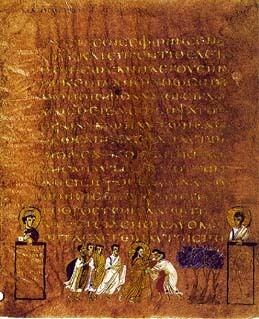Name Sinope Gospels Size 30 x 25 cm Found Sinop | Sign O Date 6th-century | |
 | ||
Similar Codex Petropolitanus Purpureus, Codex Beratinus, Rossano Gospels, Codex Petropolitanus, Codex Nitriensis | ||
The Sinope Gospels, designated by O or 023 (in the Gregory-Aland numbering), ε 21 (Soden), also known as the Codex Sinopensis, is a fragment of a 6th-century illuminated Greek Gospel Book. Along with the Rossano Gospels, the Sinope Gospels has been dated, on the basis of the style of the miniatures, to the mid 6th-century. The Rossano Gospels, however are considered to be earlier. Like Rossanensis and the Vienna Genesis, the Sinope Gospels are written on purple dyed vellum.
Contents
Description
There are only 44 extant folios in the Sinope Gospels. These folios carry unframed miniatures at the bottom of the page which are similar in style to the miniatures in the Rossano Gospels. The folios measure approximately 30 cm by 25 cm. It is written in one column per page, 15 lines per column, in silver writing and gold. It is written in very large uncial letters. The manuscript is very lacunose.
It contains five illuminated miniatures:
History
It was written in the 6th-century. The style of illustrations suggests Syria or Palestine (even Mesopotamia) as the place of its origin. The codex was purchased in 1899 at Sinope (hence its name), by a French officer from an old Greek woman. Its text was published by Henri Omont in 1901. At least one authority has suggested this manuscript has an association with a church at Çiftlik, which was under archeological excavation in 1998.
According to B. H. Streeter it is a tertiary witness of the Caesarean text-type. This opinion was supported by Bruce Metzger. Aland placed it in Category V, which means the Byzantine text-type.
43 leaves (all but one) of the codex now are located at the Bibliothèque Nationale of the Manuscrits occidentaux (Supplement Grec. 1286) at Paris.
